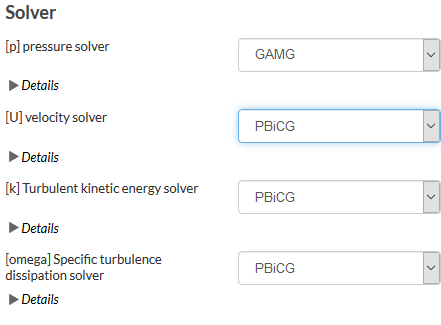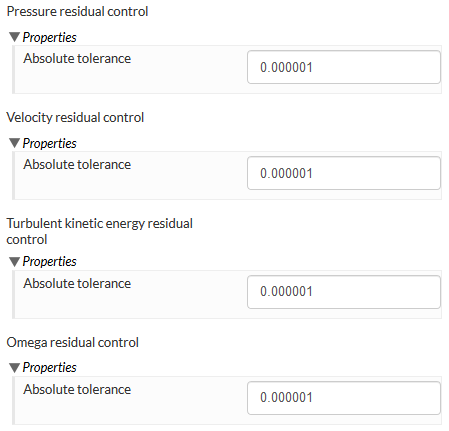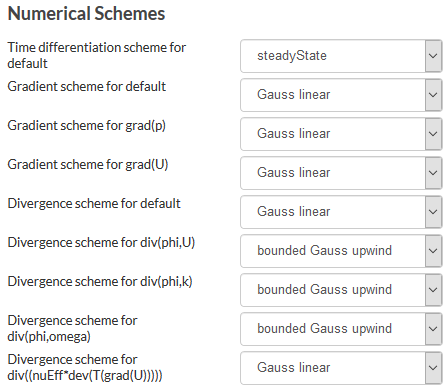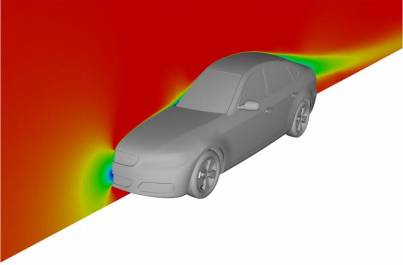Hi @DaleKramer,
Thanks for the posts on the convergence plots. I will only consider those that have either converged or reached the simulation end time. Plots like the second figure top left (R1 1 35mph 0aoa SRJ1 leastsquares) and almost all of the fourth plots except the bottom left R5 134 mph 0aoa SRJ4 fourth) are diverged and the results obtained from those cannot be used. Further adjustment may be needed in the meshes or numerical parameters in order to try to get these plots to converge. We’ll work on them probably later as higher order schemes don’t seem to yield the result behavior we expect.
If you look at the plots that do converge, we see acceptable margins for convergence even for the residuals of Ux. The residual that does not converge as well tend to be the pressure (p, yellow) and this is usually due to the mesh and how the velocity interacts with the mesh itself from what I’ve experienced. However, some simulations do give good convergence for that value and the ones that don’ t converge as well are also of acceptable convergence.
Side note, what we deem by convergence is typically having the residuals at 1E-4 and below. Ideally everything would be 1E-6 or below but 1E-4 is deemed loosely converged. We can probably set a reasonable limit of 1E-5 as the acceptable convergence margin that we’re looking for.
So, here is what I think we can try. Definitely we should try to get the results to fully converge first then get them below our arbitrary set limit of 1E-5. I suggest picking two of your best meshes (probably the SRJ4 and SJR3 or something, you can determine this), performing a first order simulation with the default solver schemes and adjusting the residual controls for pressure and all corresponding residual controls to 1E-6. I’ve attached screenshots of the default parameters you should adjust to below. Once this is done, increased the simulation end time to 2000s and post the convergence plots and result control plots here for those two meshes.



Results control is under the simulation tab and is a way to check for additional convergence while getting a good estimate on the actual values that the simulation is obtaining. You’ve already posted a result control in the second set of figures for Leastsquares, its at the top right corner. Do ensure you apply this result monitoring for both the meshes that we’re going to simulate again so we can monitor them.
After we get steady-state convergence, aka when the residuals or the result controls have reached a steady-state, we can work on bringing any less than preferred residuals down to our set limit. We will probably do this by adjusting the relaxation factors, but that will entail a longer simulation end time so we will deal with that later. Provided that of course whatever we just did to get-steady state results do not simply resolve our continued divergence in results.
The possibility of small issues in meshes causing large deviations in results is very well possible. Whether it is worth it for the user to spend significant amount of time refining their meshes or troubleshooting in order to negate this discrepancy may be debatable based on why exactly this occurs. So yes I would say we should start a topic on this. However, I would like to resolve this issue of yours first before we move on. Then we can spend our efforts tacking the other topic. You are welcome however to start on it if you do have ample free time.
Looking forward to the results. Cheers.
Regards,
Barry
EDIT: On a side note of peculiar issues with the mesher that has not been resolved. I’ve encountered several issues like in this post where the mesh seems to behave very strangely. Maybe we can start a mega-thread (with your observation about each mesh not being the same) and post all the peculiar problems and try to fix or understand them. It would then be very beneficial for everyone once we figure it out and post the solution.



